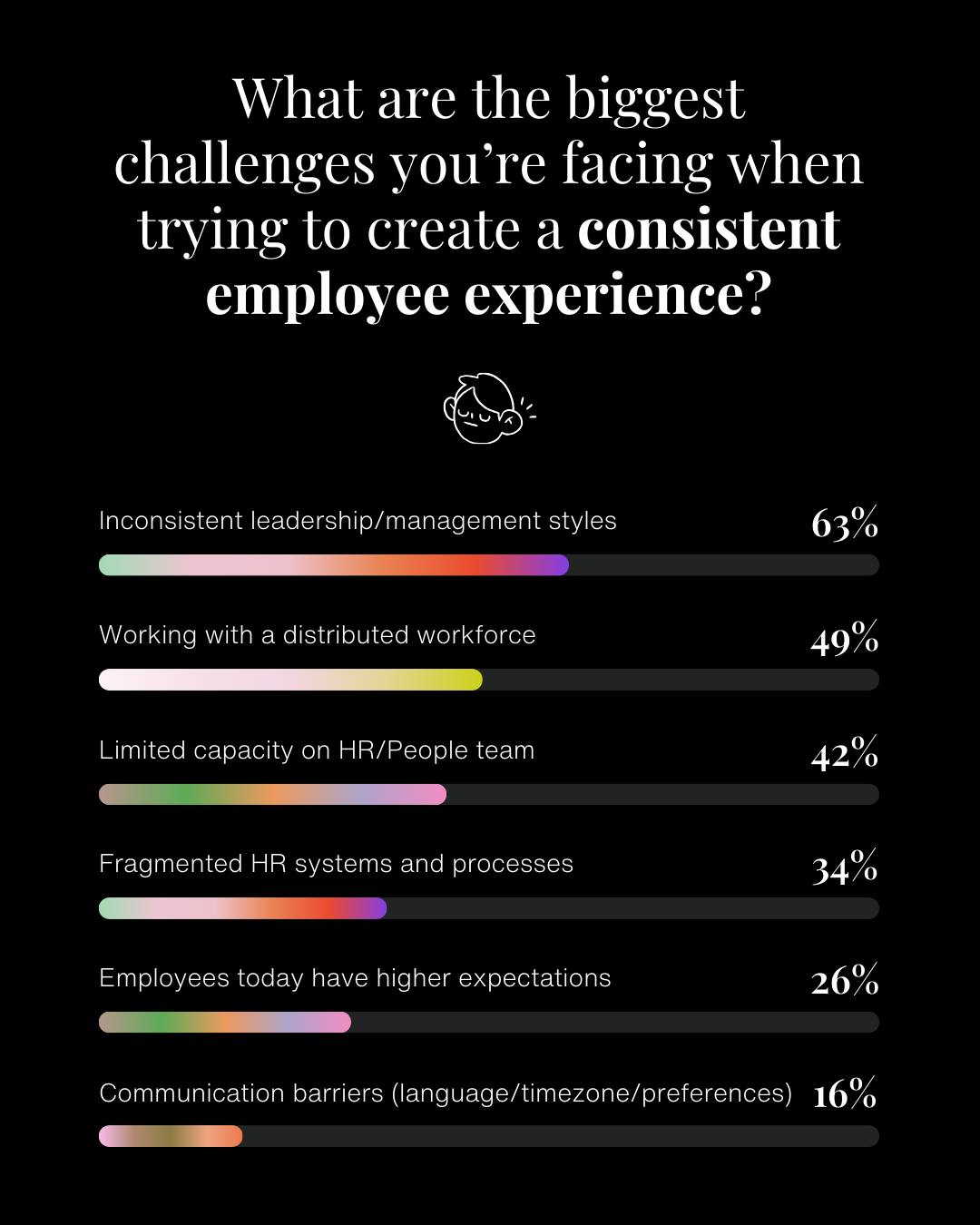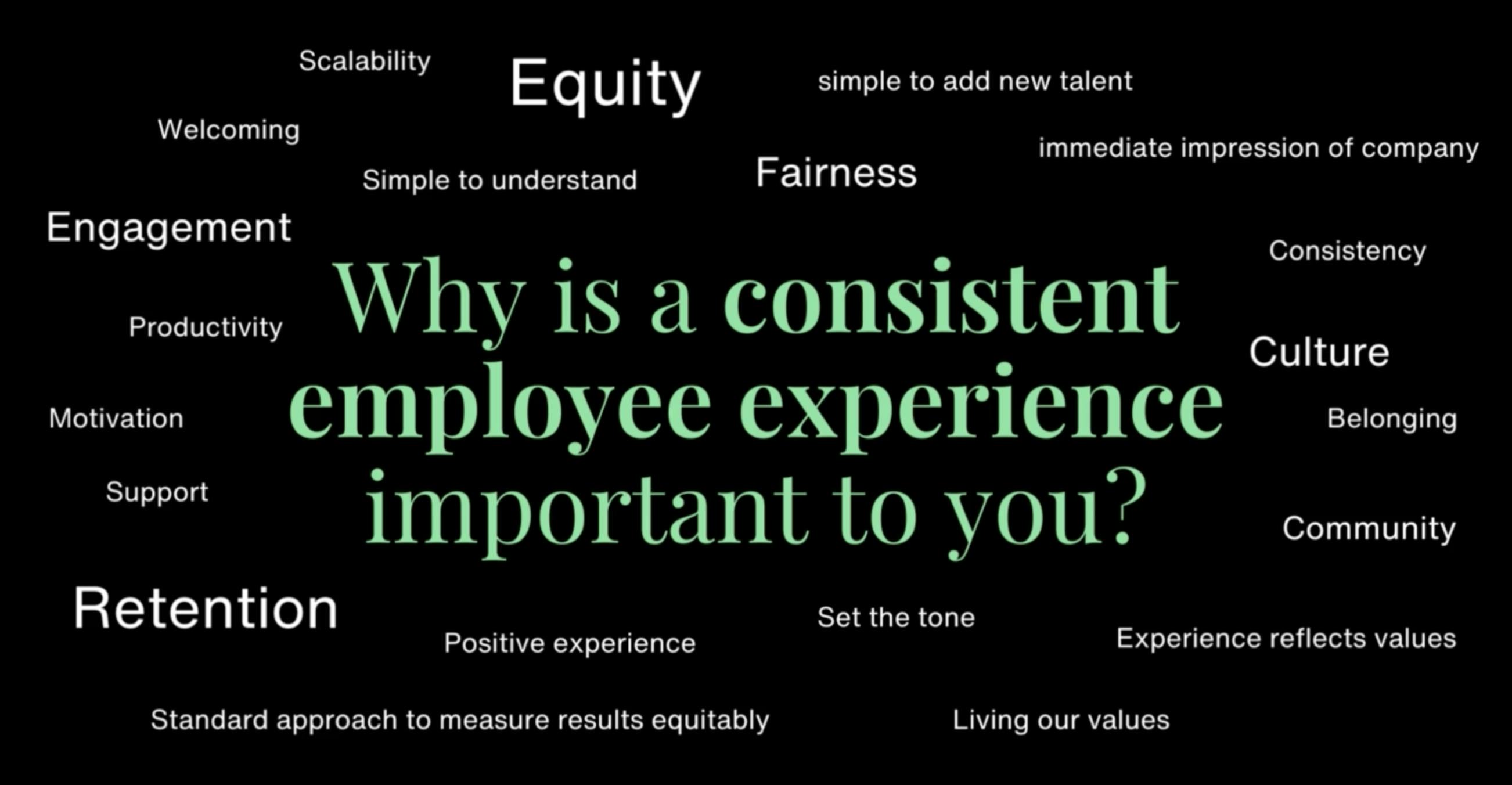
How employee journey mapping creates a more consistent employee experience

Written by
Alexis (Lexi) Croswell, Customers
From sales calls and conversations with our community, we’re hearing HR leaders say how important it is to build a consistent employee experience.
But that consistency can be hard to execute on and may never be “complete.”
You’re working across geographies, cultures, teams, tenures…the list goes on. Gathering all the moments that matter across all of these variables, to ensure they’re consistent, is hard.
However, just like chasing a 100% employee engagement score isn’t the goal, a 100% consistent employee experience isn’t likely to be achieved. Even so, that doesn’t make the chase a less worthy endeavor.
Taking into account what we’ve been hearing from our community on this topic, we hosted a webinar - How to create consistency across the employee experience - with a few of our customers to discuss how Pyn can help companies create a more consistent employee experience. This article summarizes that discussion on consistency, taking into account conversations with our community.
What is a consistent employee experience?
A consistent employee experience is a uniform and predictable set of interactions, policies, and practices that employees encounter throughout their tenure at a company.
This means that no matter where your employees are located, who their manager is, how tenured they are, etc., they encounter a uniform and predictable set of interactions.
This doesn’t mean that everyone is having the same experience, explains Stacey Nordwall, Pyn’s VP of People Strategy.
“It might not be practical or realistic for everyone to have exactly the same experience. But what you're doing is finding ways to still create that connectivity, to create something that does feel kind of an equal experience, or like an equitable experience. And so I think it's really important to highlight that consistency might look a little bit different in actuality, but it means that people are still feeling that connection, feeling that those moments are being recognized and acknowledged.”
Challenges of creating a consistent employee experience
During our webinar on creating a consistent employee experience, we polled our attendees on the biggest challenges they’re facing when trying to create a consistent employee experience. Respondents could select more than one option.
The top challenges were:
- Inconsistent leadership/management styles
- Working with a distributed workforce
- Limited capacity on HR/People team

Let’s explore each challenge and how a solution like Pyn’s employee journey mapping and automated employee communication capabilities can help.
Inconsistent leadership/management styles
An employee’s experience with your company can vary greatly depending on who their manager is. Research from Culture Amp has shown that employees with great managers (whom they see as a role model) score 27% points higher on motivation. “This means that great managers help organizations get the best out of their employees,” they explain.
Imagine the different ways that managers interact with their team members on a daily basis. From work-based conversations to important milestones in an employee’s personal life, manager interactions have a significant impact on the employee experience.
Anne O’Gara, Director of Learning & Development MongoDB says they view managers as a conduit of the employee experience. “Our team's focus has often been on, how do we support managers in creating this consistency for employees so that they're modeling what we believe to be the effective tools and frameworks and ways of thinking about management?”
Their new manager cohorts are both first-time managers and more senior managers who had previous experience. “We were trying to find a balance of being able to customize for that different experience. And I think Pyn allowed us to really speak to those different audiences. We're in a real fight for attention, so being able to modify our messages slightly based on seniority level or by location, or just basic stuff, like making sure it gets there during their working day and not at 10pm at night, helps it to feel more personalized,” Anne explains.
By mapping out the experience for new managers, and automating important touchpoints along the way, you can ensure that managers are getting the information and support they need to show up for their team members.
Mary Newville, Director of People Experience at Arctic Wolf says it can be challenging to answer 20 questions from new managers all at once. “So Pyn allowed us to address what are those questions we're getting asked all the time? Let's answer them at scale. Let's think of them before the person even has to ask and deliver it to them when they need it,” says Mary.
Working with a distributed workforce
Many companies were forced into distributed or remote work years ago due to the pandemic. Some have made returns to the office, but many have recommitted to the remote lifestyle. This doesn’t mean the challenges that come with working remotely have disappeared.
Take Australian-based furniture company Koala for example. In their flexible, hybrid, and globally distributed workplace, communication is crucial. Group Culture Officer, Netta Efron, explains, with employees spread out across the globe, consistent messaging and appropriate context surrounding key information, particularly when it comes to changes or pivots, is important.
“We move super fast, change priorities, shift things,” says Netta, “How we communicate the changes and the pivots is quite critical.”
Mapping out your employee journey to compare the in-office employee experience to that of remote employees can be a crucial first step to a more consistent experience across a distributed workforce.
Limited capacity on HR/People team
Many companies are facing the challenge of understaffed HR teams today. Because understaffed teams have to spend time keeping things afloat in the present, they have less time and energy to invest in improving things for the future - like mapping and improving the employee experience.
There are so many items on the agenda of an HR person every day. Balbina Knight, VP, People & Culture at Thrive Digital shares, “The thing that we've also additionally gotten value from with Pyn is not having to remember all the little things that are like very significant personalized moments for people in their employee experience which really just end up accumulating as like our to do list debt, because things are popping up at work.”
“If you're in HR, you know, no day is predictable. There's probably a people problem or something that's gonna arise. Maybe you had an agenda for yourself for that day where you're like, I'm gonna send these three messages to these three employees to celebrate something for them. And it's like. Nope, that your calendar is wiped now, sorry, you're gonna have to go focus and prioritize your time and attention elsewhere. And now that employee experience has been compromised because maybe you're able to send one of those tomorrow, and maybe two of those the following week.
So really like being able to relieve that burden, I think, from the team just and not having cobwebs growing on these to-do lists has been really important. And yeah, it's just been so helpful for us to make sure there's that consistency.”
Automating manual tasks for your HR team can’t solve every understaffing problem. But by reducing the manual workload of your team, you can free up time and energy for more important and strategic tasks.
You can still deliver a personalized and consistent employee experience as well. For example, with Pyn, you can customize the content of each message based on different demographic variables. So that new hires who are remote vs. in-office get customized day one instructions, and employees in the London office get messages scheduled during their workday versus late at night.
“Pyn totally is the fifth member of the people experience team helping us support all of our new hires and managers in a way that we honestly could not without it,” adds Mary.
Why a consistent employee experience is important
We asked our webinar audience why a consistent employee experience was important to them, and equity and retention were the top two themes.

Equity is about promoting justice and fairness within the procedures, processes, and distribution of access, opportunities, and resources by a company. Focusing on consistency of the employee experience can often be the first step towards a more equitable experience.
For example, in reviewing your company’s employee journey map, you could find out if there are inequities across different variables, like how does a remote worker’s experience compare to one who is in the office? Do employees on different teams or of different backgrounds get the same access to advancement opportunities?
For retaining employees, many factors influence retention, and the quality and consistency of the employee experience makes an impact on all of them - think onboarding, becoming a manager, employee anniversaries, crisis communication - and more.
Stacey explains, “I think retention is a huge issue right now when it comes to why consistency is important. If employees are feeling like someone else is having a different experience, they’re going to feel like it’s unfair that they don’t have the same opportunities. So I think retention, fairness and equity are all important.”
As you can tell from the word cloud, there are many other reasons that having a consistent employee experience is important. Why it matters at your company will influence how you go about improving the employee experience.
How Pyn helps build a consistent employee experience
We’ve mentioned a few ways throughout this article that employee journey mapping and automation with Pyn help build a consistent employee experience, so here’s a quick summary to tie everything together.
Employees get the information they need when they need it
- Automated messages are delivered at the right time, so no employee is left without support.
When you help your People team, you help your people experience
- Automating tedious manual tasks and getting them off the workload of your team frees them up for more strategic projects.
Personalized employee communications are more impactful
- Messages that speak directly to the individual employee or manager, delivered in their timezone, help ensure that people feel valued and understood.
Building connection across distributed organizations
- Foster community across geographies by understanding and proactively planning for moments that matter across the employee journey.
Most HR leaders get started with Pyn by automating employee onboarding, scaling support for new managers, personalizing anniversary and milestone messages, or organizing HR calendars (reviews, holidays, etc.). You'll get access to an easy-to-use Employee Journey Map template that you can customize for your first use case. Interested in learning more about how Pyn can support your company? Book time to speak with our CEO and Cofounder, Joris.

Lexi enjoys reading, hosting clothing swaps, and her dog, Tessa. She worked at Culture Amp and Torch.
